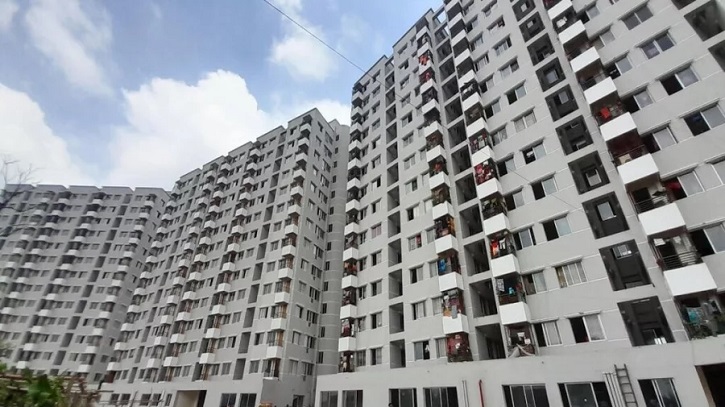Many residents concerned about monthly rent
Adapting to clean environment and modern amenities
On October 26, 2017, Prime Minister Sheikh Hasina issued a directive for the construction of rental-based residential flats for shantytown dwellers.
As a result of this initiative, five buildings with 14 floors and modern amenities were constructed for slum dwellers on a six bigha land in the Baunia Beribandh area adjacent to Kalshi in Mirpur Section 11, funded by the National Housing Authority.
At present, 300 flats in three buildings have already been handed over to the slum dwellers, with another 233 flats in two other buildings awaiting completion and handover.
Residents from Mirpur’s Kalabagan shantytown, who are living in these flats, expressed their satisfaction after transitioning from an uninhabitable and unhealthy environment to a clean and modern one.
Some residents have even adorned their new homes with new furniture, and various types of flowers are flourishing on the balconies of most flats.
The residents are overjoyed with the opportunity to live in these modern flats, as it fulfills their long-standing dream of having a comfortable place to call home.
Modern features
The flats offer a clean environment and modern facilities, doing away with the feeling of deprivation.
Each flat measures between 620 and 719 square feet and includes two bedrooms, a balcony, a drawing room, a basin, a kitchen, a separate toilet, and a separate bathroom.
These tiled flats have ample open space on both sides to facilitate air circulation.
Each building is equipped with modern amenities, including two lifts, wide staircases, a community hall, fire-fighting and solar power systems, a 40KVA generator, a 250KVA substation, wide walkways, and decorative lighting.
The ground floor of each building is designated for common use by tenants, and there is space in front of the building for the recreation of small children and teenagers.
A bustling community
Initially, many shantytown residents were hesitant to move into the flats, waiting to see if it would truly benefit them.
However, they eventually made the move, although they discovered that rent calculation began right after receiving the keys, resulting in some residents facing several months of rent arrears.
One resident, who wished to remain anonymous, expressed disappointment with the rental arrangement and suggested that offering the flats with an installment payment option would have been more beneficial for the residents’ financial stability.
Despite the initial challenges, most residents are gradually adapting to the clean and healthy environment of the flats.
While they were accustomed to lower living costs, they are now learning to manage their finances in their new homes.
They hope that over time, living in these flats will become a more comfortable and sustainable way of life.
Rent issue
The implementation of this project has provided slum dwellers with the opportunity to live in modern flats at affordable rents.
However, some residents are facing financial pressure due to the rising prices of daily necessities and goods coupled with low incomes.
People who have been allotted flats are paying a rent of Tk5,900, including service charges.
Selina Begum, one of the flat recipients, shared her experience. She and her family, including her husband, one daughter, one son, and her son’s wife, had been residing in Mirpur’s Kalabagan shantytown for the last 30 years.
She described the harsh living conditions before, with cramped shack houses and no proper bathing facilities.
Selina expressed her gratitude for the opportunity to live in a flat, albeit with the financial challenge of affording the rent in Dhaka city.
Morjina Akhter, another resident, emphasized the positive change in her family’s living conditions. However, she mentioned the financial strain of the higher rent compared to the slum.
She said: “It’s great that I have been able to keep my children in a good place. But our income is very low. There was no cost to stay in the slums. I had to pay Tk500 for electricity and water. Now I have to pay rent every month. There are also Gas bills, electricity bills and other expenses.”
She said if the rent was lower it would be beneficial for her family and also her neighbours.
What authorities say
Housing authorities believe that this initiative will not only improve the quality of life for shantytown residents but also enhance the local environment.
Importantly, residents have the flexibility to pay the rent at any time during the month.
Bijoy Kumar Mandal, a member of the Planning, Design, and Special Projects Department of the National Housing Authority, emphasized the transformative impact of the initiative on shantytown dwellers’ lives.
He highlighted that this project, born from Prime Minister Sheikh Hasina’s vision, was executed on government-owned land and with government funding.
Regarding the determination of rent, Bijoy explained that the market rate for these flats would be at least Tk15,000.
However, recognizing the financial constraints of slum dwellers, the government set the rent at only Tk4,500. Additionally, a service charge of Tk1,900 covers various expenses, including water, security, cleaning, elevators, and supervision, ensuring the sustainability of the project.
As the rent is a fraction of the market rate, Bijoy believes that it will contribute to the well-being of the residents and their future generations.
Source: Dhaka Tribune.

